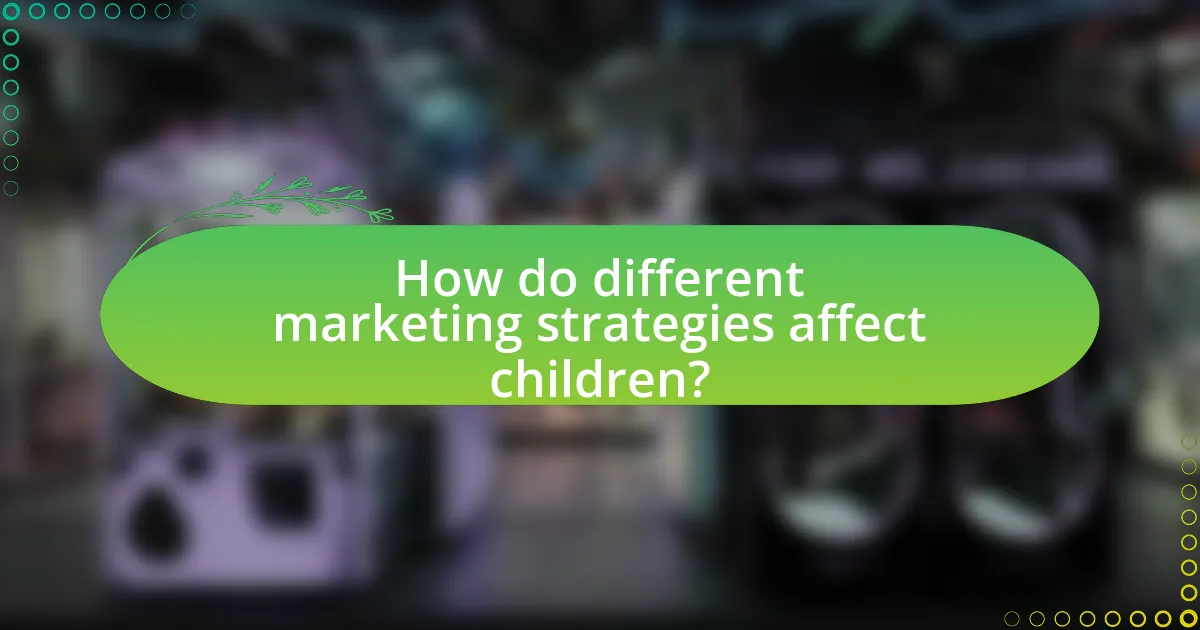The article focuses on the ethical considerations in marketing to children, emphasizing the need to protect their vulnerability and ensure truthful advertising. It discusses the unique vulnerabilities of children as consumers, the impact of marketing on their development and behavior, and the importance of promoting healthy choices. Key ethical principles include honesty, transparency, and the safeguarding of children’s privacy, supported by various regulations and self-regulatory codes. The article also highlights the negative effects of marketing on children’s self-esteem and body image, while providing best practices for marketers to engage responsibly with young audiences.

What are the Ethical Considerations in Marketing to Children?
Ethical considerations in marketing to children include the protection of their vulnerability, ensuring truthful advertising, and promoting healthy behaviors. Children are impressionable and may not fully understand the persuasive intent behind marketing messages, which raises concerns about exploitation. For instance, the American Psychological Association highlights that children under eight often cannot distinguish between commercials and programming, making them susceptible to misleading claims. Additionally, marketing practices should avoid promoting unhealthy food choices, as research from the World Health Organization indicates that such advertising contributes to childhood obesity. Therefore, ethical marketing to children necessitates transparency, responsibility, and a commitment to their well-being.
Why is it important to consider ethics in marketing to children?
It is important to consider ethics in marketing to children because children are impressionable and may not fully understand the persuasive intent behind advertisements. Ethical marketing practices protect children from exploitation and manipulation, ensuring that they are not subjected to misleading or harmful messages. Research indicates that children are particularly vulnerable to advertising tactics, as they often lack the cognitive skills to critically evaluate marketing claims. For instance, a study published in the Journal of Consumer Research found that children under the age of eight are unable to distinguish between commercials and regular programming, highlighting the need for ethical standards in marketing directed at this demographic.
What unique vulnerabilities do children have as consumers?
Children have unique vulnerabilities as consumers due to their limited cognitive development and inability to critically evaluate marketing messages. Their understanding of persuasive intent is underdeveloped, making them more susceptible to manipulation through advertising techniques that exploit their emotions and desires. Research indicates that children under the age of eight often cannot distinguish between commercial content and entertainment, leading to increased susceptibility to misleading advertisements. Additionally, children are influenced by peer pressure and social dynamics, which can further compromise their decision-making abilities in consumer contexts. These factors collectively highlight the ethical concerns surrounding marketing practices directed at children, necessitating protective measures to safeguard their interests.
How does marketing impact children’s development and behavior?
Marketing significantly influences children’s development and behavior by shaping their preferences, attitudes, and consumption patterns. Research indicates that exposure to marketing messages can lead to increased materialism and unhealthy eating habits among children. For instance, a study published in the journal “Pediatrics” found that children exposed to food advertising were more likely to choose unhealthy snacks over healthier options, demonstrating a direct link between marketing and dietary choices. Additionally, marketing strategies often exploit children’s developmental stages, making them more susceptible to persuasive messages, which can affect their social skills and self-esteem. This manipulation raises ethical concerns regarding the responsibility of marketers in protecting vulnerable populations like children.
What are the key ethical principles in marketing to children?
The key ethical principles in marketing to children include protecting their vulnerability, ensuring truthful advertising, and promoting healthy behaviors. Protecting children’s vulnerability involves recognizing their limited ability to understand persuasive intent, which necessitates a higher standard of care in marketing practices. Truthful advertising mandates that marketers provide accurate information about products, avoiding misleading claims that could exploit children’s naivety. Promoting healthy behaviors encourages marketers to consider the impact of their messages on children’s physical and mental well-being, advocating for products that contribute positively to their development. These principles are supported by guidelines from organizations such as the American Psychological Association, which emphasizes the need for responsible marketing practices that prioritize children’s welfare.
How do honesty and transparency play a role in ethical marketing?
Honesty and transparency are fundamental to ethical marketing as they build trust between marketers and consumers. When marketers provide clear, truthful information about their products, they empower consumers to make informed decisions, which is especially crucial when marketing to children who may not fully understand advertising tactics. Research indicates that transparent marketing practices can lead to increased customer loyalty and brand reputation, as consumers are more likely to support brands that they perceive as honest. For instance, a study published in the Journal of Business Ethics found that companies demonstrating transparency in their marketing strategies experienced a 20% increase in consumer trust. This trust is essential in ethical marketing, particularly when targeting vulnerable populations like children, ensuring that their interests are prioritized over profit.
What is the significance of protecting children’s privacy in marketing?
Protecting children’s privacy in marketing is significant because it safeguards their personal information from exploitation and manipulation. Children are particularly vulnerable to marketing tactics that can influence their behavior and decision-making, making it essential to ensure their data is handled responsibly. Research indicates that children may not fully understand the implications of sharing personal information, which can lead to privacy violations and potential harm. For instance, the Children’s Online Privacy Protection Act (COPPA) mandates that websites directed at children under 13 must obtain parental consent before collecting personal data, highlighting the legal framework designed to protect young consumers. This legal protection underscores the importance of ethical marketing practices that prioritize children’s rights and well-being.
What regulations exist regarding marketing to children?
Regulations regarding marketing to children include the Children’s Online Privacy Protection Act (COPPA) in the United States, which mandates parental consent for the collection of personal information from children under 13. Additionally, the Federal Trade Commission (FTC) enforces guidelines that prohibit deceptive advertising practices targeting children. In the European Union, the Audiovisual Media Services Directive (AVMSD) restricts advertising aimed at children, particularly during children’s programming, to protect them from misleading content. These regulations aim to safeguard children’s welfare and ensure that marketing practices are ethical and transparent.
What are the main laws governing advertising to children in different countries?
The main laws governing advertising to children vary significantly across countries. In the United States, the Children’s Online Privacy Protection Act (COPPA) restricts the collection of personal information from children under 13, while the Federal Trade Commission (FTC) enforces guidelines on advertising practices aimed at children. In the European Union, the Audiovisual Media Services Directive (AVMSD) sets strict rules on advertising to minors, including limitations on the timing and content of such advertisements. In Canada, the Broadcasting Act and the Canadian Code of Advertising Standards impose regulations to protect children from misleading advertising. These laws are designed to safeguard children from exploitation and ensure that advertising is appropriate for their age group.
How do self-regulatory codes impact marketing practices aimed at children?
Self-regulatory codes significantly influence marketing practices aimed at children by establishing guidelines that restrict misleading or harmful advertising. These codes, such as the Children’s Advertising Review Unit (CARU) guidelines, require marketers to ensure that advertisements are not deceptive and do not exploit children’s inexperience or credulity. For instance, CARU mandates that advertisements must clearly distinguish between content and commercial messages, thereby reducing the likelihood of children being misled. Research indicates that adherence to these codes can lead to a decrease in aggressive marketing tactics, promoting a more ethical approach to advertising directed at younger audiences.

How do different marketing strategies affect children?
Different marketing strategies significantly affect children by shaping their preferences, behaviors, and consumption patterns. For instance, strategies that utilize colorful visuals, catchy jingles, and characters familiar to children can lead to increased brand recognition and loyalty. Research indicates that children exposed to television advertisements are more likely to request advertised products, with studies showing that children aged 2 to 11 can recognize brands after just a few exposures (Nielsen, 2018). Furthermore, marketing strategies that employ social media and influencer partnerships can create a sense of peer approval, influencing children’s purchasing decisions and fostering materialistic values. The American Psychological Association has highlighted that such marketing tactics can contribute to unhealthy eating habits and unrealistic body images among children, emphasizing the need for ethical considerations in marketing practices aimed at this vulnerable demographic.
What types of marketing strategies are commonly used to target children?
Common marketing strategies used to target children include the use of animated characters, interactive games, and social media platforms. These strategies leverage children’s affinity for entertainment and engagement, making products more appealing. For instance, brands often create mascots or cartoon figures that resonate with young audiences, enhancing brand recognition and loyalty. Additionally, interactive games and apps that incorporate brand messaging can effectively capture children’s attention, as evidenced by the success of mobile games that feature product placements. Social media platforms, particularly those popular among younger demographics, are also utilized to reach children through influencer partnerships and engaging content.
How does the use of characters and celebrities influence children’s purchasing decisions?
The use of characters and celebrities significantly influences children’s purchasing decisions by leveraging their emotional connections and aspirational desires. Research indicates that children are more likely to request products endorsed by familiar characters or celebrities, as these figures create a sense of trust and excitement. For instance, a study published in the Journal of Consumer Research found that children aged 4 to 6 were more inclined to choose snacks featuring popular cartoon characters over those without, demonstrating the power of character association in driving preferences. Additionally, celebrities often embody traits that children admire, such as success and popularity, which can lead to increased brand loyalty and a higher likelihood of purchase requests.
What role does digital marketing play in reaching child audiences?
Digital marketing plays a crucial role in reaching child audiences by utilizing platforms and strategies that are specifically designed to engage younger demographics. Children are increasingly active on digital platforms such as social media, gaming apps, and video streaming services, making these channels effective for marketers aiming to connect with them. For instance, a study by the American Psychological Association found that children aged 8 to 12 spend an average of 6 hours a day consuming media, highlighting the importance of digital marketing in capturing their attention. Additionally, digital marketing allows for targeted advertising, enabling brands to tailor their messages based on children’s interests and behaviors, which can enhance engagement and brand loyalty.
What are the potential negative effects of marketing on children?
Marketing can have several potential negative effects on children, including the promotion of unhealthy eating habits, materialism, and distorted body image. Research indicates that exposure to advertisements for unhealthy food products can lead to increased consumption of these items, contributing to childhood obesity. A study published in the journal “Pediatrics” found that children who are frequently exposed to fast food advertisements are more likely to choose those foods over healthier options. Additionally, marketing strategies often emphasize materialistic values, which can lead to a sense of entitlement and dissatisfaction among children. Furthermore, advertisements frequently portray unrealistic body standards, which can negatively impact children’s self-esteem and body image, as highlighted in research from the “Journal of Adolescent Health.” These effects underscore the ethical concerns surrounding marketing practices aimed at children.
How can exposure to advertising lead to unhealthy lifestyle choices?
Exposure to advertising can lead to unhealthy lifestyle choices by promoting products that encourage poor dietary habits and sedentary behaviors. Research indicates that children exposed to high levels of food advertising are more likely to choose unhealthy snacks and beverages, contributing to obesity and related health issues. For instance, a study published in the journal “Pediatrics” found that children who viewed more food advertisements consumed significantly more calories than those who viewed fewer ads. This correlation highlights how targeted marketing strategies exploit children’s susceptibility to advertising, ultimately influencing their food preferences and activity levels in detrimental ways.
What impact does marketing have on children’s self-esteem and body image?
Marketing negatively impacts children’s self-esteem and body image by promoting unrealistic standards of beauty and success. Research indicates that exposure to idealized images in advertisements can lead to body dissatisfaction among children, as they often compare themselves to these unattainable ideals. A study published in the journal “Pediatrics” found that girls exposed to thin-ideal media reported lower self-esteem and higher levels of body dissatisfaction. Additionally, the American Psychological Association has highlighted that marketing strategies targeting children often emphasize appearance, which can contribute to negative self-perception and unhealthy behaviors.

What best practices should marketers follow when targeting children?
Marketers should prioritize transparency and age-appropriate messaging when targeting children. This involves using clear language that children can understand and avoiding deceptive practices that could mislead them. Research indicates that children are particularly vulnerable to advertising, as they may not fully grasp the intent behind marketing messages. For instance, the American Psychological Association highlights that children under eight often cannot distinguish between programming and advertising, making it crucial for marketers to create content that is clearly labeled as promotional. Additionally, marketers should ensure that their products are safe and suitable for children, adhering to regulations such as the Children’s Online Privacy Protection Act (COPPA), which protects the privacy of children under 13 online. By following these best practices, marketers can engage responsibly with young audiences while fostering trust and ethical standards in their campaigns.
How can marketers ensure ethical practices in their campaigns aimed at children?
Marketers can ensure ethical practices in their campaigns aimed at children by adhering to strict guidelines that prioritize the well-being and rights of young audiences. These guidelines include avoiding deceptive advertising, ensuring that content is age-appropriate, and promoting positive values. For instance, the Children’s Advertising Review Unit (CARU) provides a set of self-regulatory guidelines that emphasize honesty and transparency in marketing directed at children. Additionally, marketers should engage in regular assessments of their campaigns to ensure compliance with legal standards, such as the Children’s Online Privacy Protection Act (COPPA), which protects children’s personal information online. By following these established frameworks and continuously monitoring their practices, marketers can uphold ethical standards in their advertising efforts targeted at children.
What guidelines should be followed to create age-appropriate content?
To create age-appropriate content, it is essential to ensure that the material is suitable for the cognitive and emotional development of the target age group. Content should avoid themes that are too complex or mature, focusing instead on relatable experiences and language that children can understand. For instance, research from the American Academy of Pediatrics emphasizes that media content should promote positive social behaviors and avoid violence or fear-inducing scenarios. Additionally, guidelines from the Children’s Advertising Review Unit recommend that advertisements directed at children should not mislead or exploit their inexperience. By adhering to these principles, content creators can effectively engage young audiences while respecting their developmental needs.
How can marketers engage parents in the marketing process to promote ethical standards?
Marketers can engage parents in the marketing process to promote ethical standards by actively involving them in product development and feedback mechanisms. This engagement can be achieved through surveys, focus groups, and community forums where parents can express their values and expectations regarding marketing practices aimed at children. Research indicates that 70% of parents prefer brands that prioritize ethical marketing, highlighting the importance of aligning marketing strategies with parental concerns. By incorporating parental insights, marketers not only enhance trust but also ensure that their campaigns reflect ethical standards that resonate with families.
What resources are available for marketers to learn about ethical marketing to children?
Marketers can access various resources to learn about ethical marketing to children, including guidelines from organizations like the American Psychological Association, which provides research on the impact of marketing on children. Additionally, the Children’s Advertising Review Unit offers best practices and standards for responsible advertising to children. Academic journals such as the Journal of Advertising Research publish studies on ethical marketing practices, while books like “Marketing to Children: A Handbook for Educators” by David L. Smith provide comprehensive insights. These resources collectively emphasize the importance of ethical considerations in marketing strategies aimed at children.
What organizations provide guidelines and support for ethical marketing practices?
Organizations that provide guidelines and support for ethical marketing practices include the American Marketing Association (AMA), the Federal Trade Commission (FTC), and the International Chamber of Commerce (ICC). The AMA offers a Code of Ethics that emphasizes honesty, fairness, and transparency in marketing. The FTC enforces regulations to protect consumers from deceptive advertising practices, ensuring that marketing to children is conducted responsibly. The ICC provides a framework for responsible marketing communications, promoting ethical standards globally. These organizations collectively contribute to establishing and maintaining ethical marketing practices, particularly in sensitive areas such as marketing to children.
How can marketers stay informed about changes in regulations and ethical standards?
Marketers can stay informed about changes in regulations and ethical standards by regularly consulting industry publications, attending relevant conferences, and participating in professional organizations focused on marketing ethics. These resources provide updates on legal changes and best practices. For instance, the American Marketing Association offers guidelines and resources that reflect current ethical standards in marketing. Additionally, subscribing to newsletters from regulatory bodies, such as the Federal Trade Commission, ensures marketers receive timely information on compliance requirements. Engaging with legal experts and attending workshops can further enhance understanding of evolving regulations.
What are some practical tips for implementing ethical marketing strategies for children?
To implement ethical marketing strategies for children, marketers should prioritize transparency, age-appropriate messaging, and parental involvement. Transparency involves clearly communicating the purpose of marketing messages and ensuring that children understand the content without manipulation. Age-appropriate messaging requires marketers to tailor their content to the cognitive and emotional development stages of children, avoiding complex or misleading information. Parental involvement can be encouraged by providing resources and information that help parents guide their children’s media consumption. Research indicates that ethical marketing practices not only foster trust but also enhance brand loyalty among families, as seen in studies by the American Psychological Association, which highlight the importance of responsible advertising to children.






